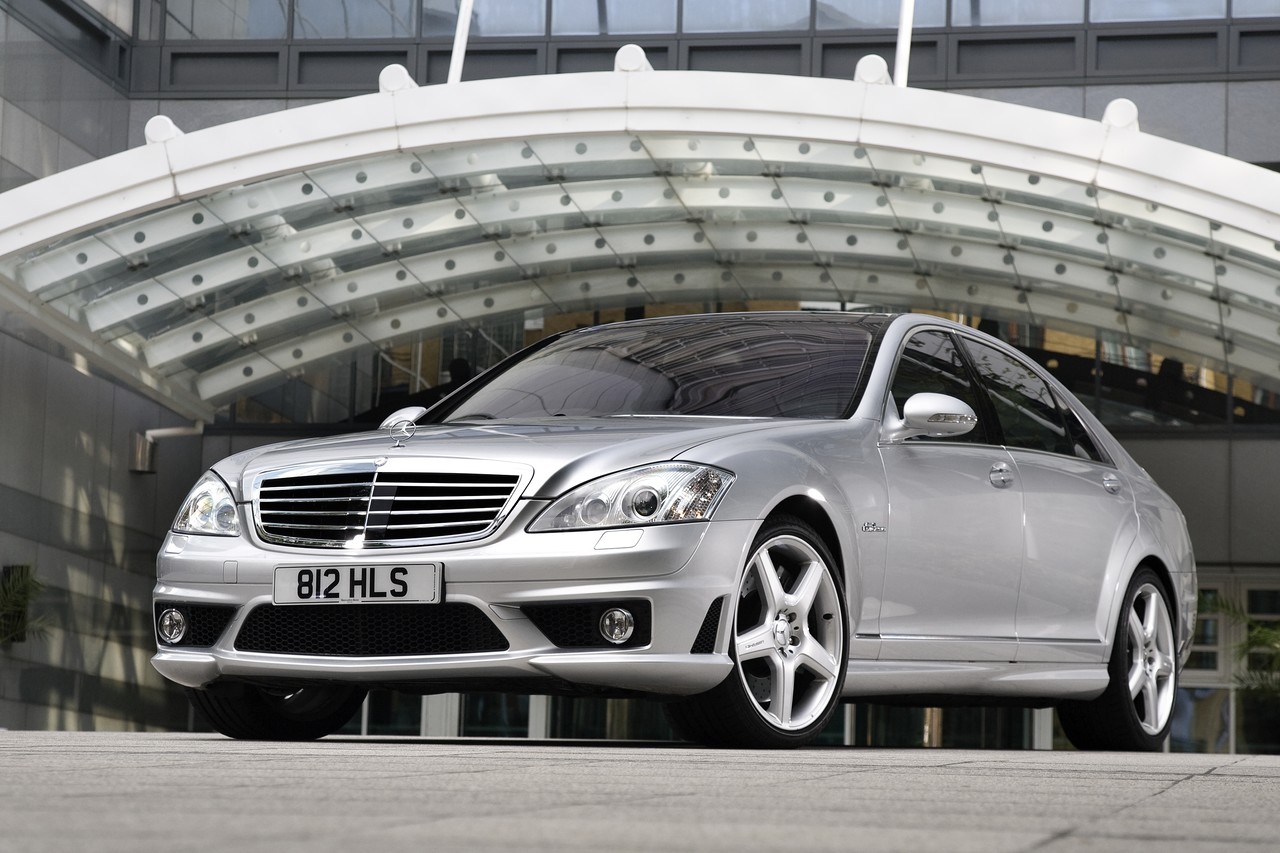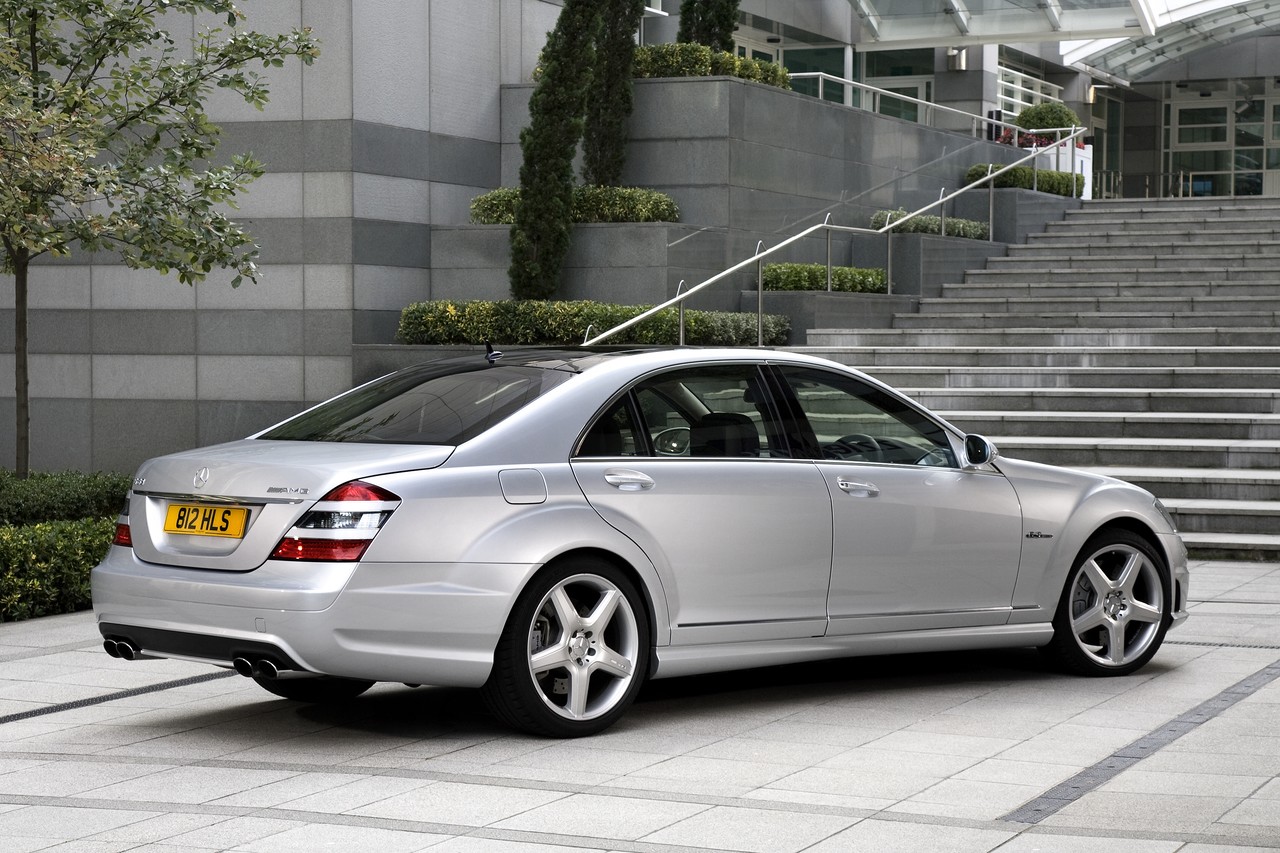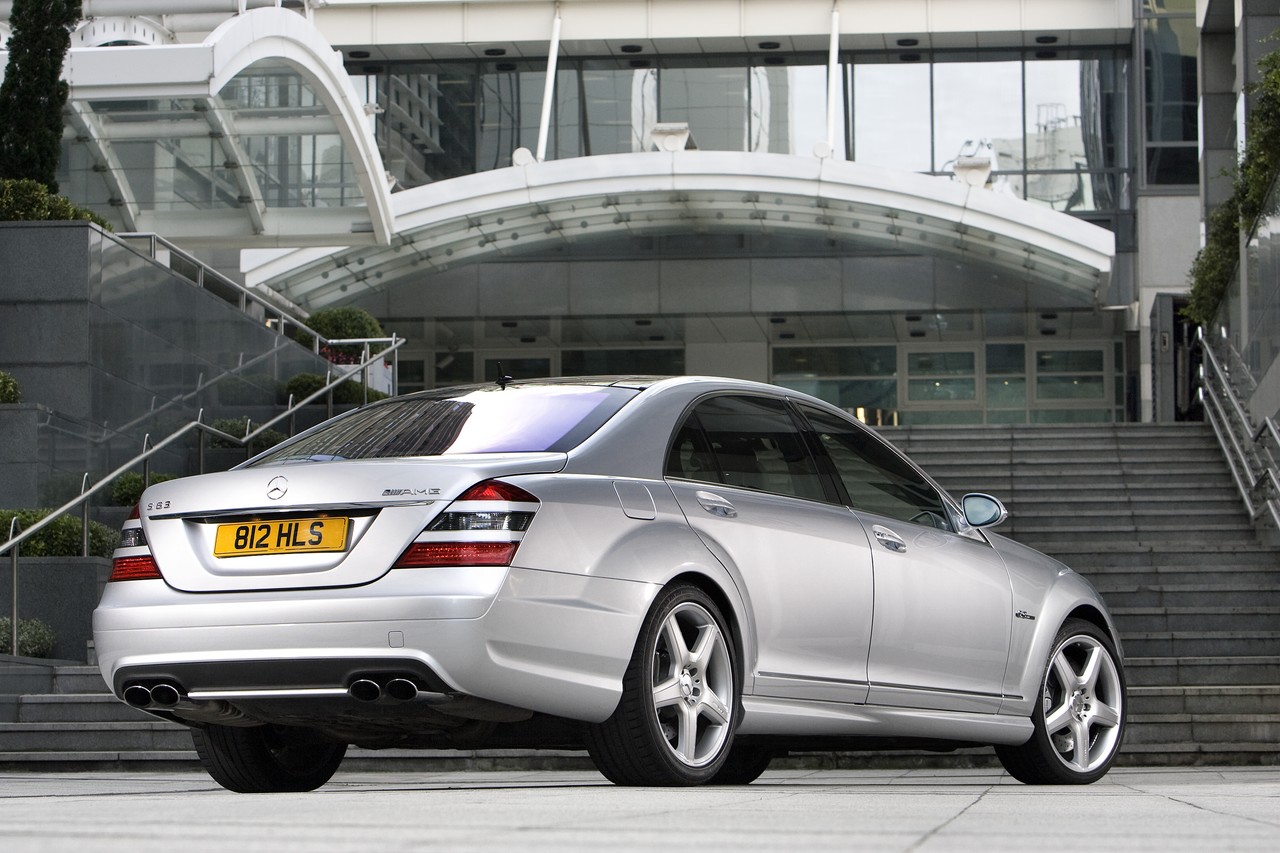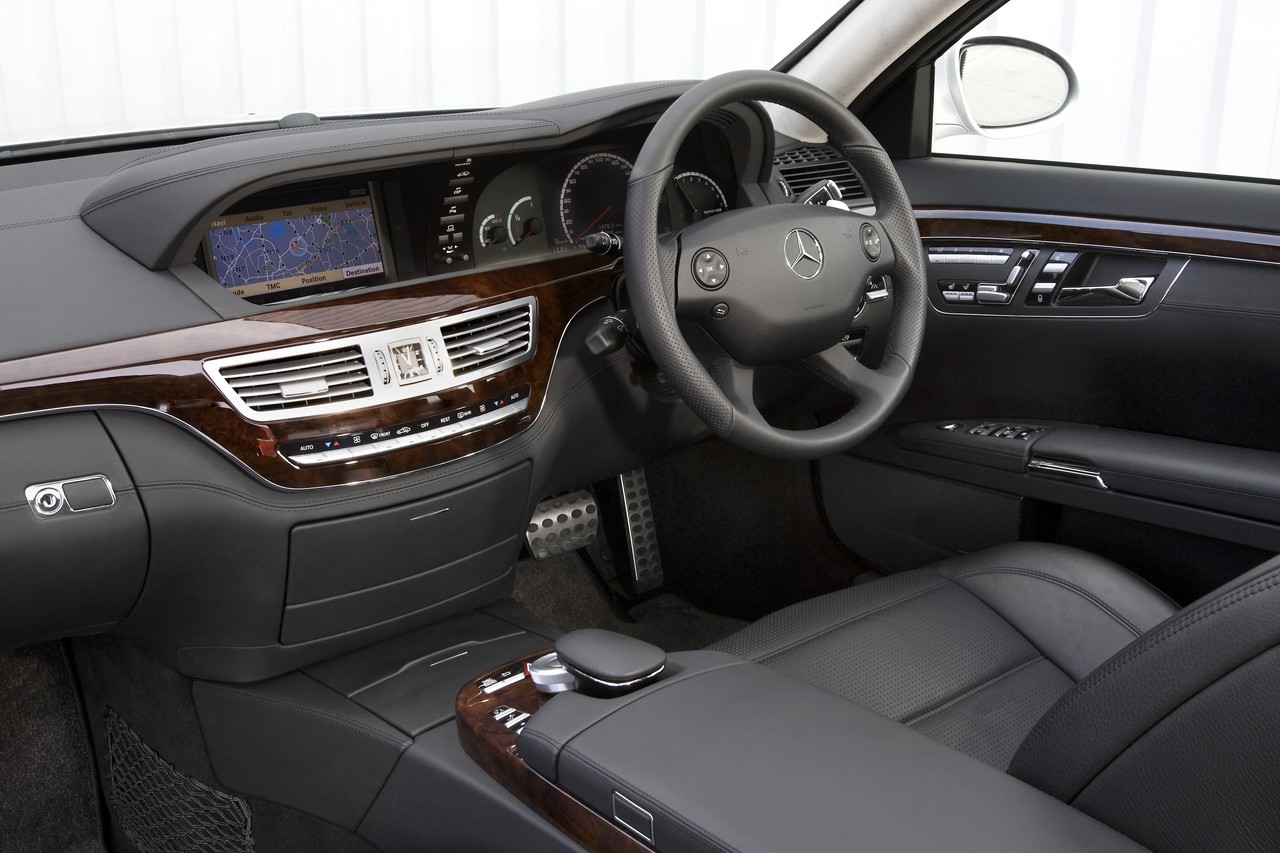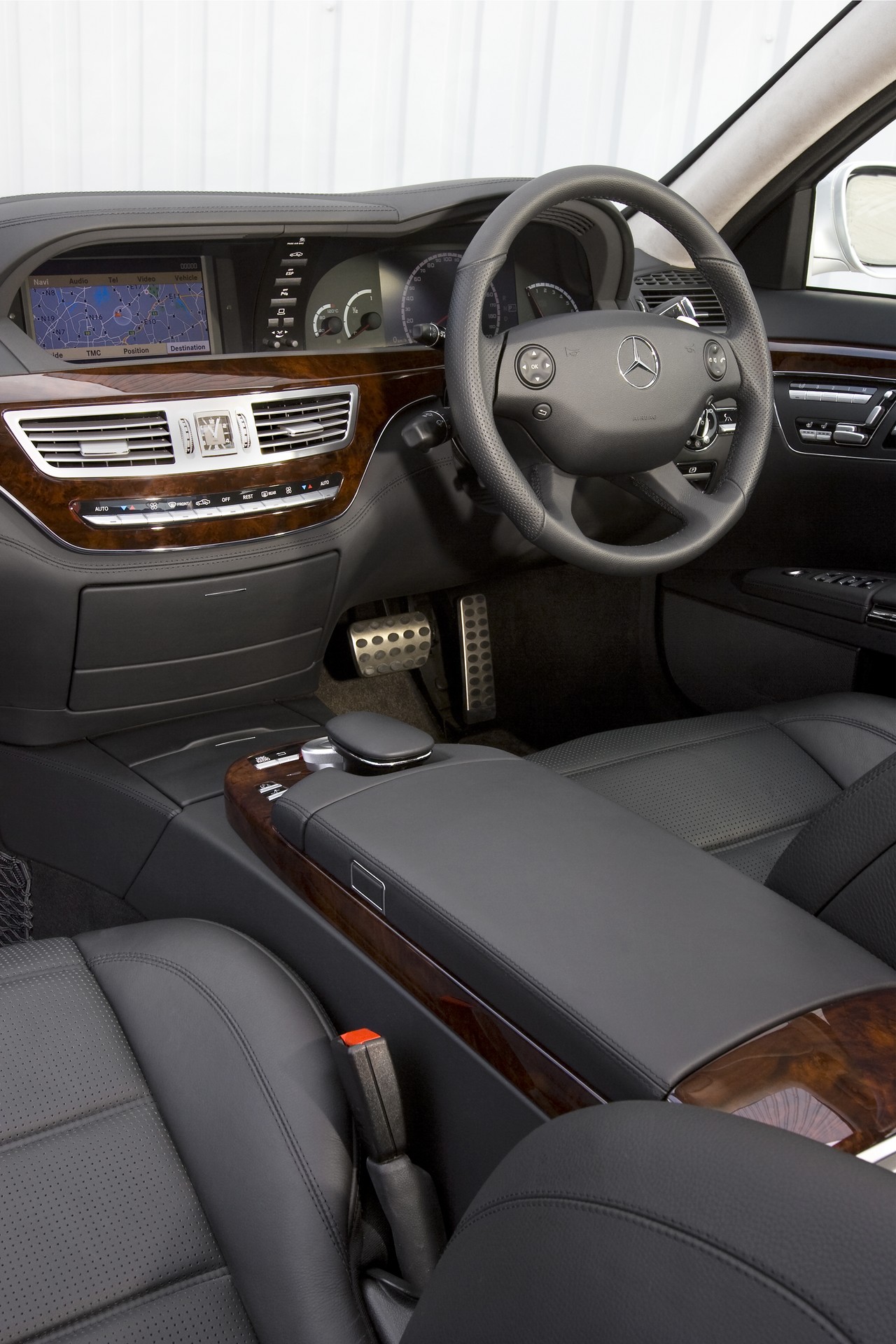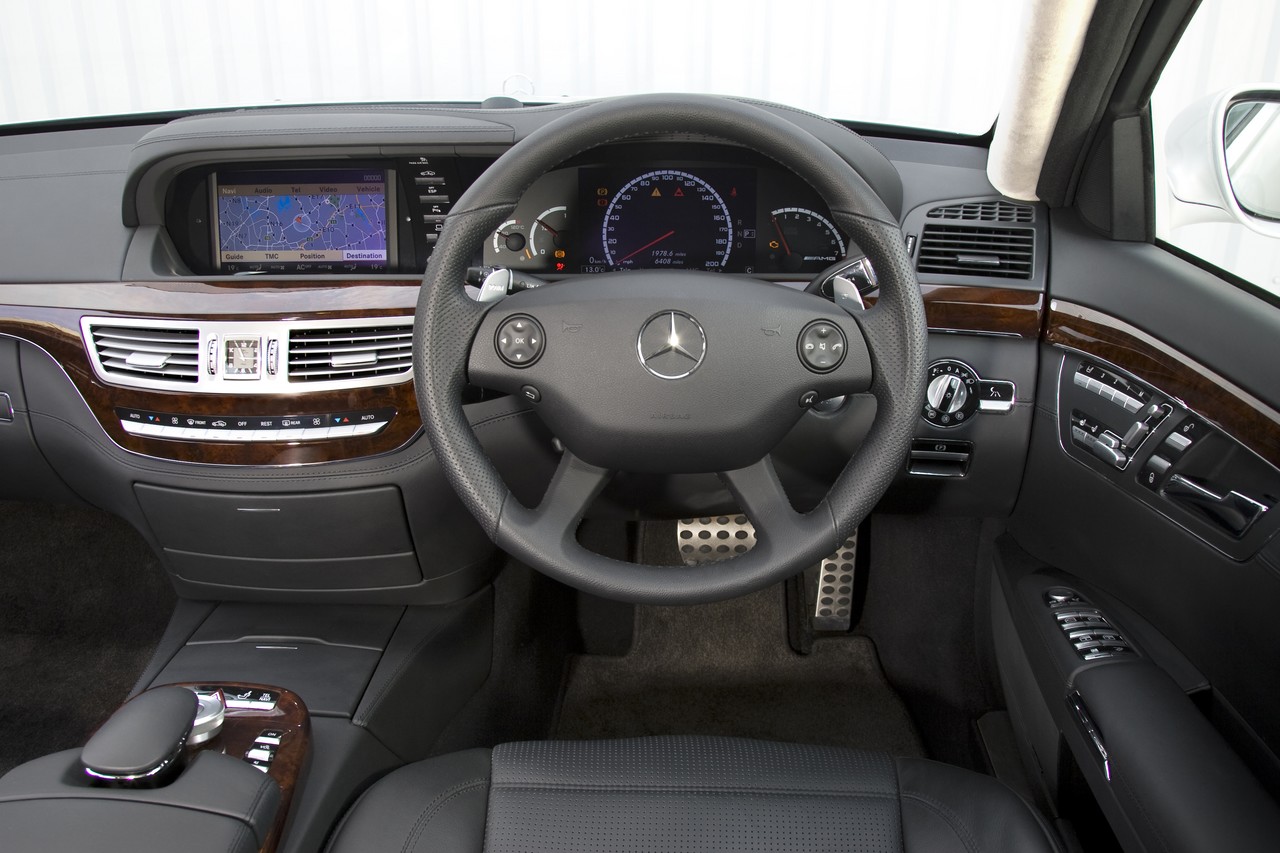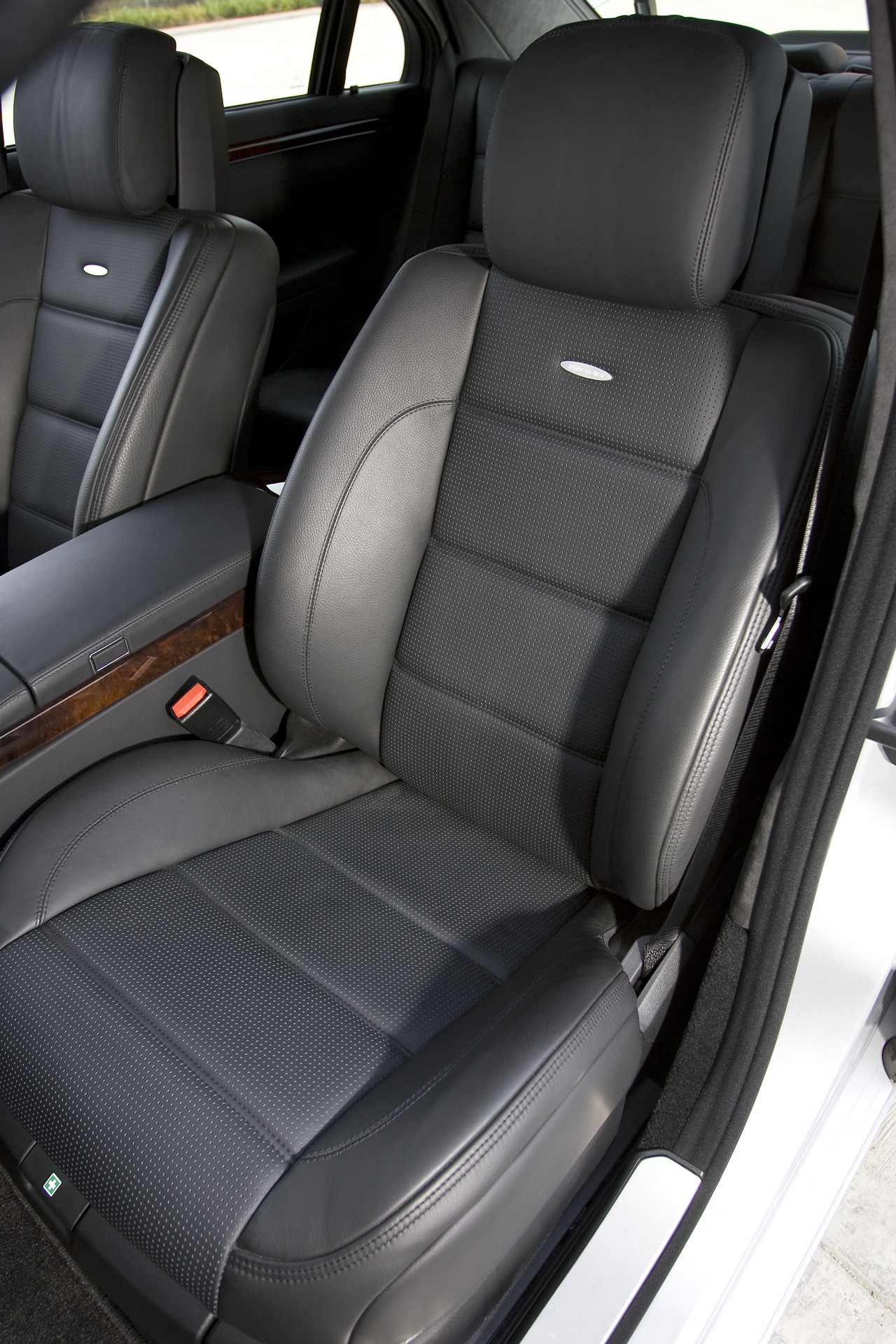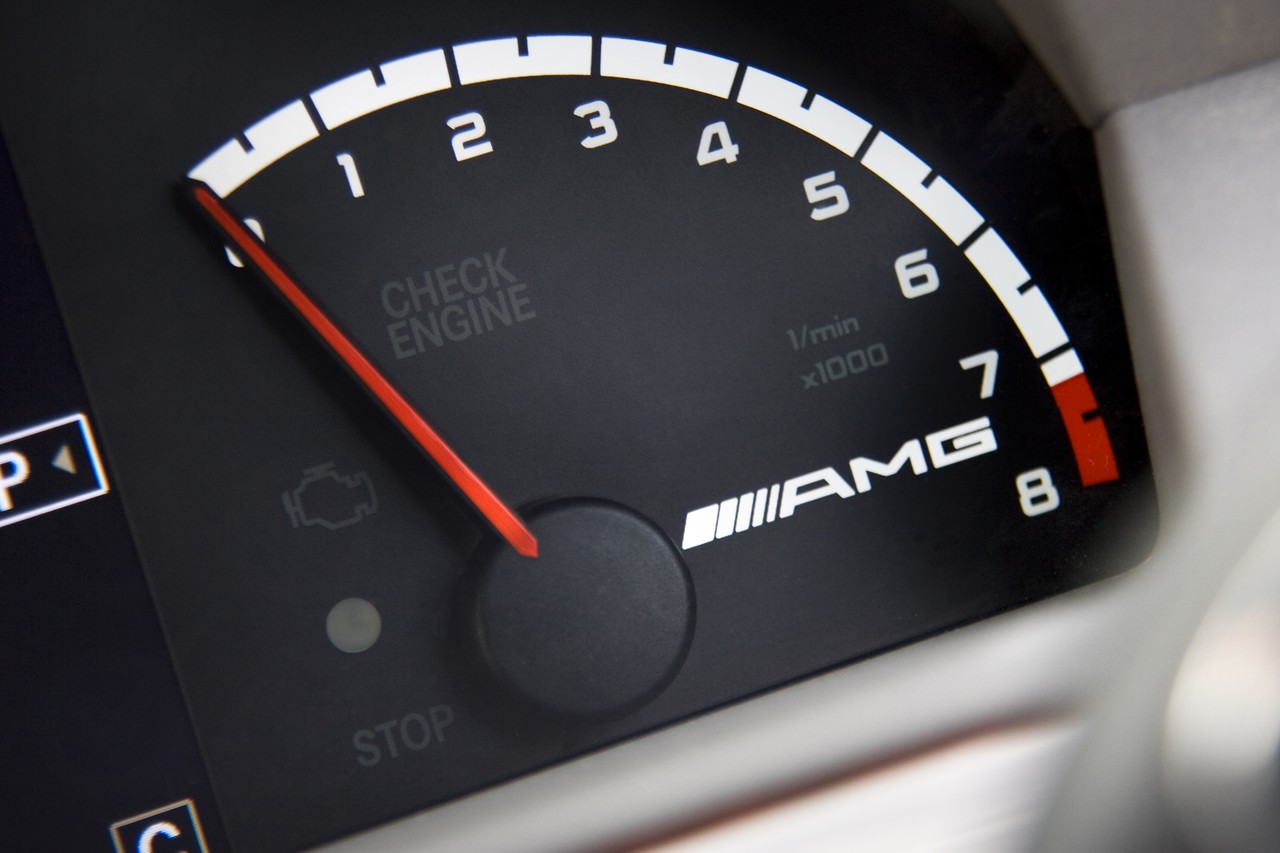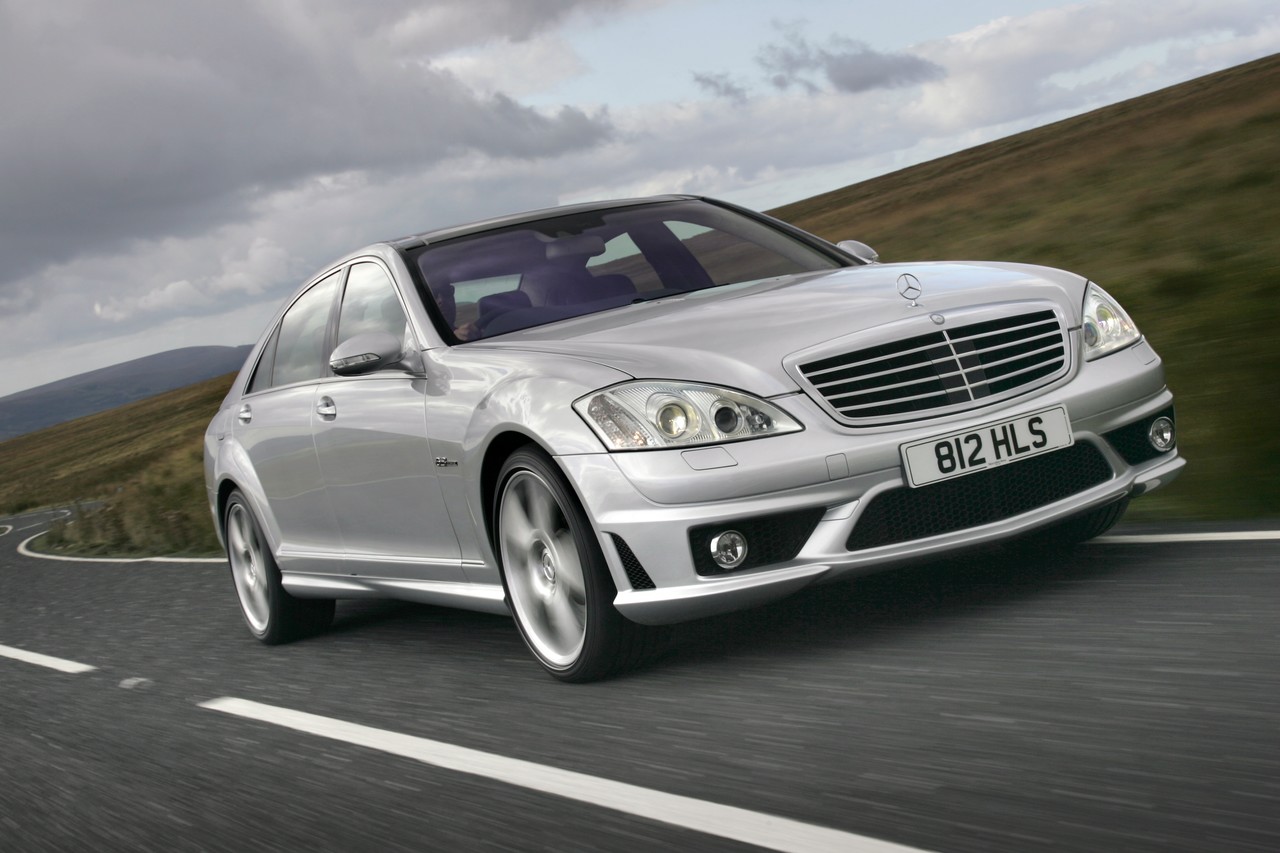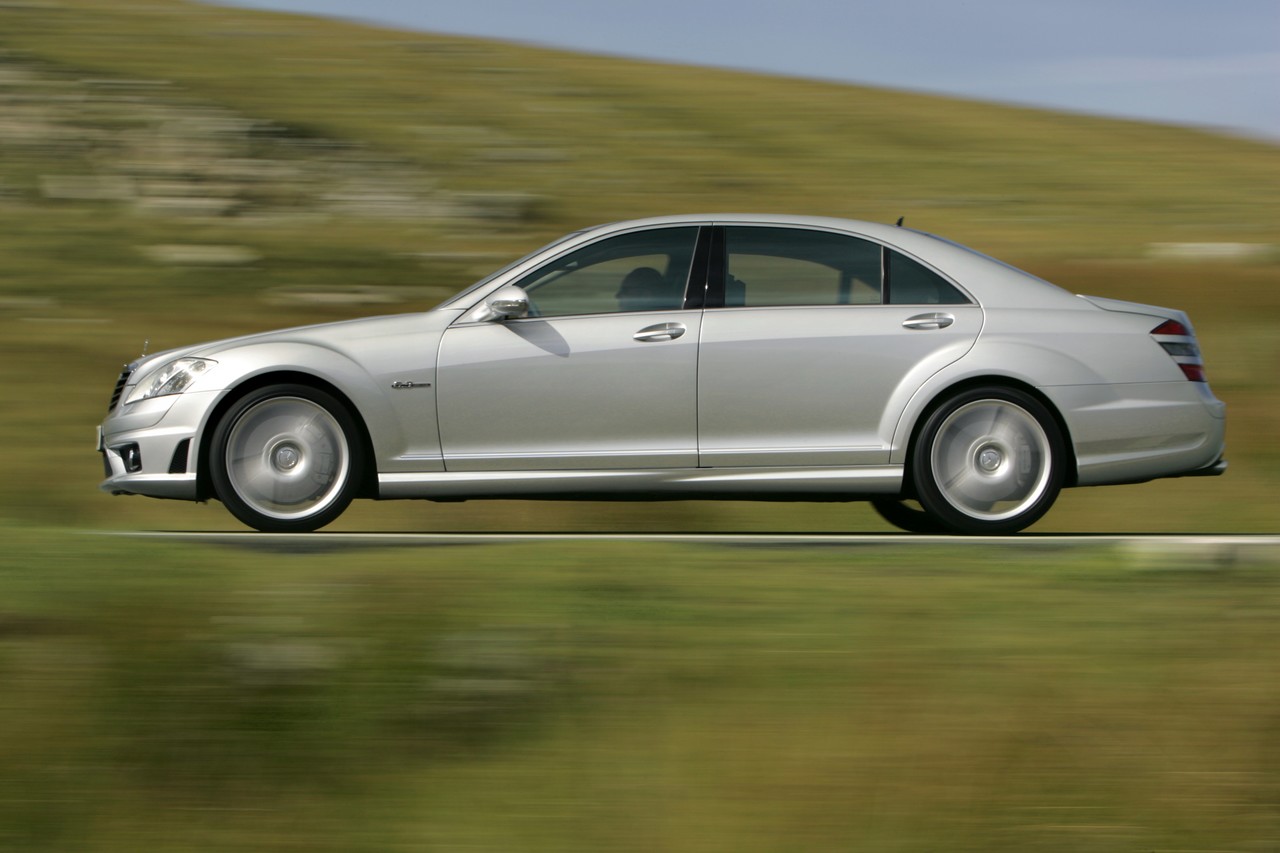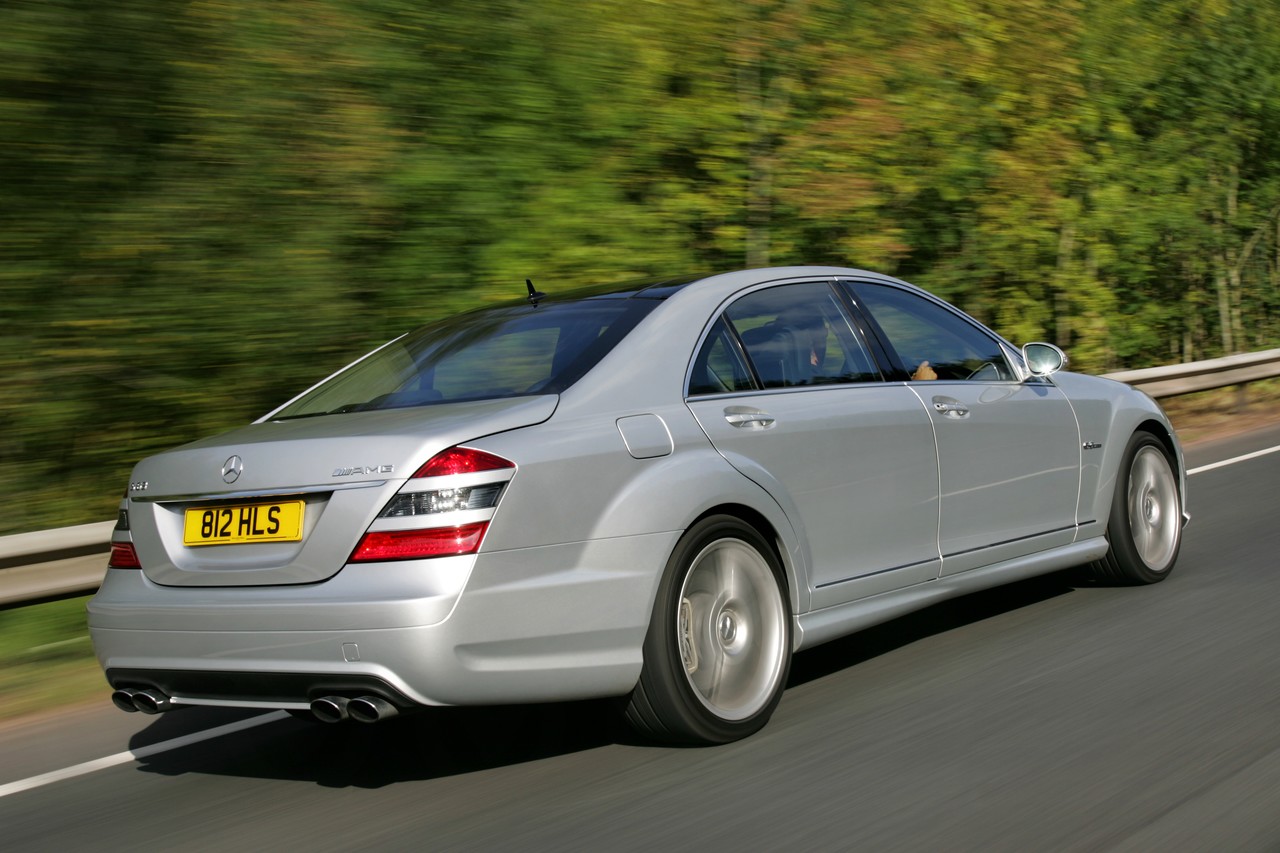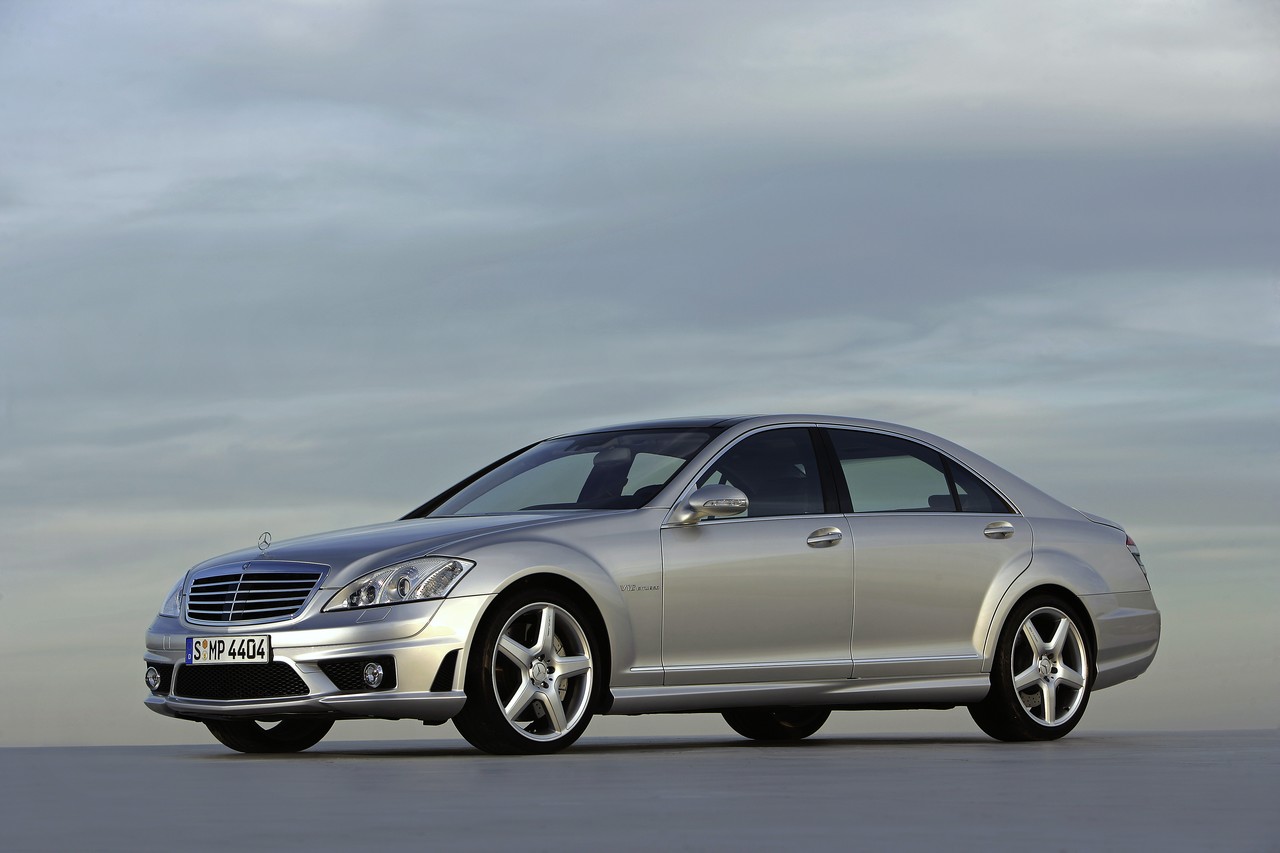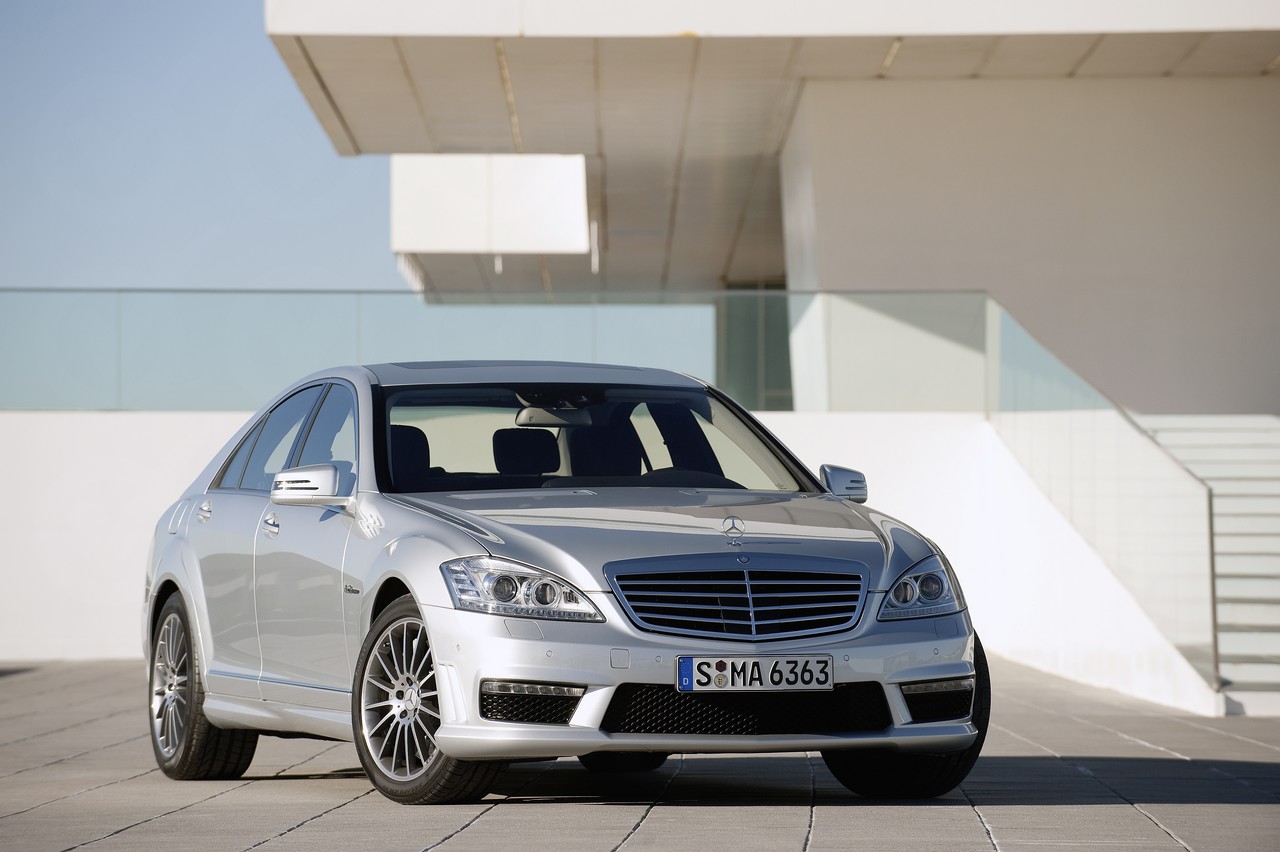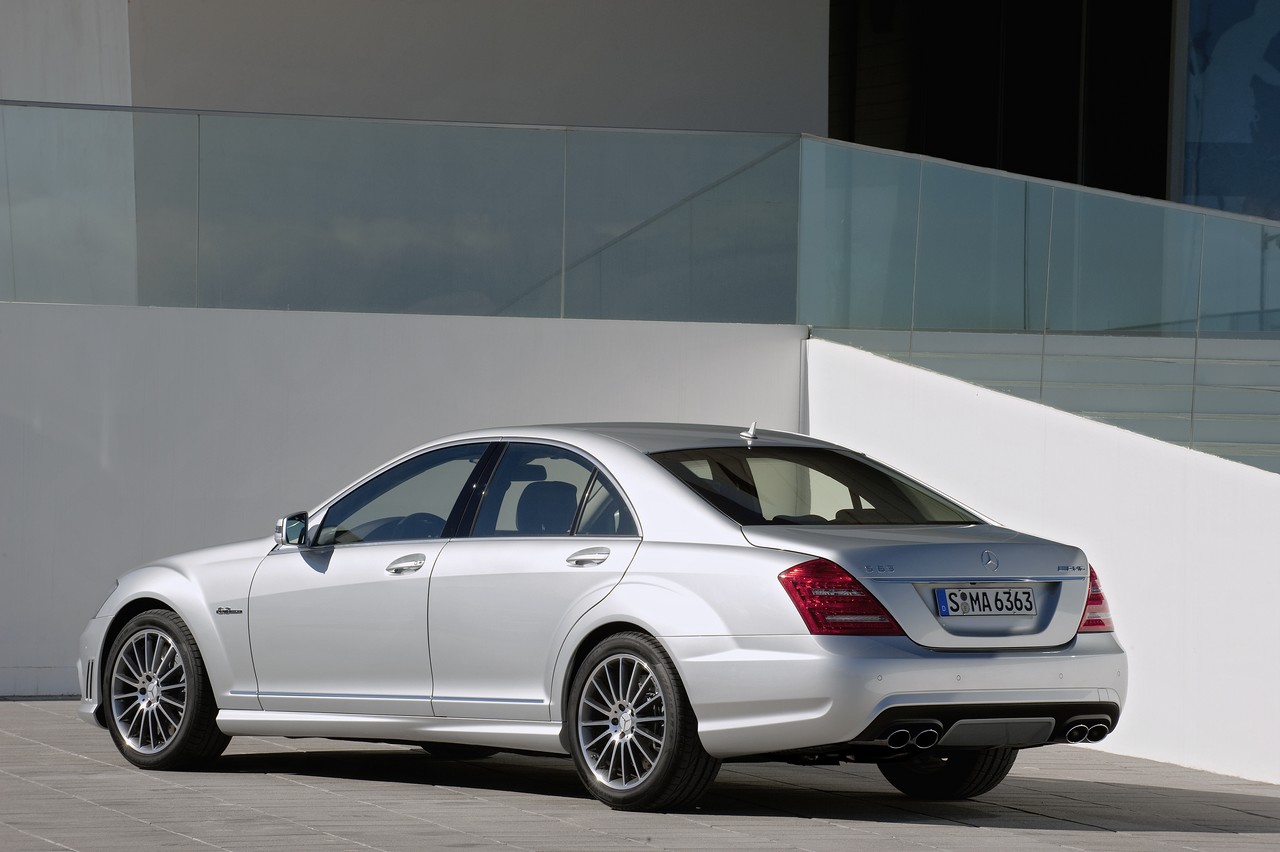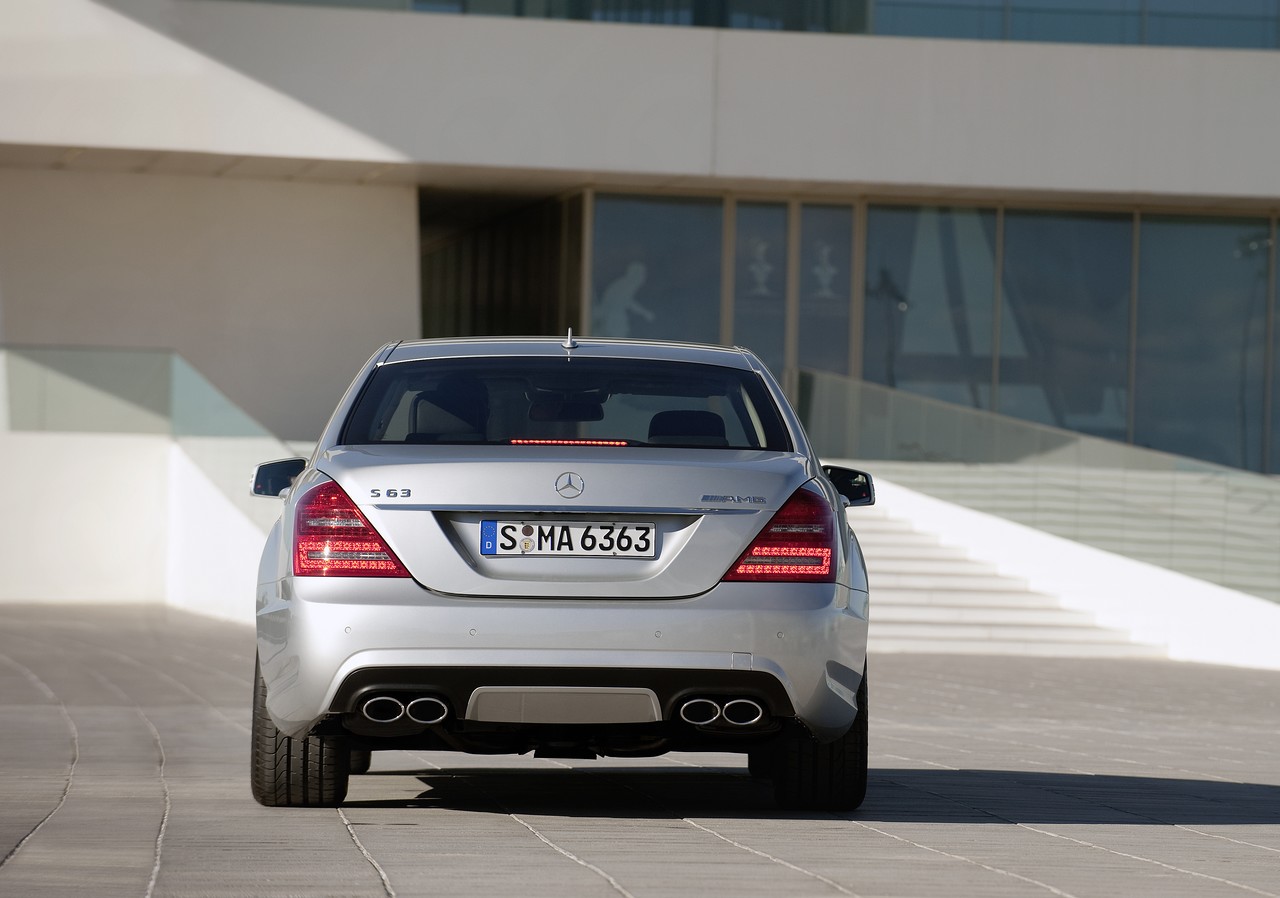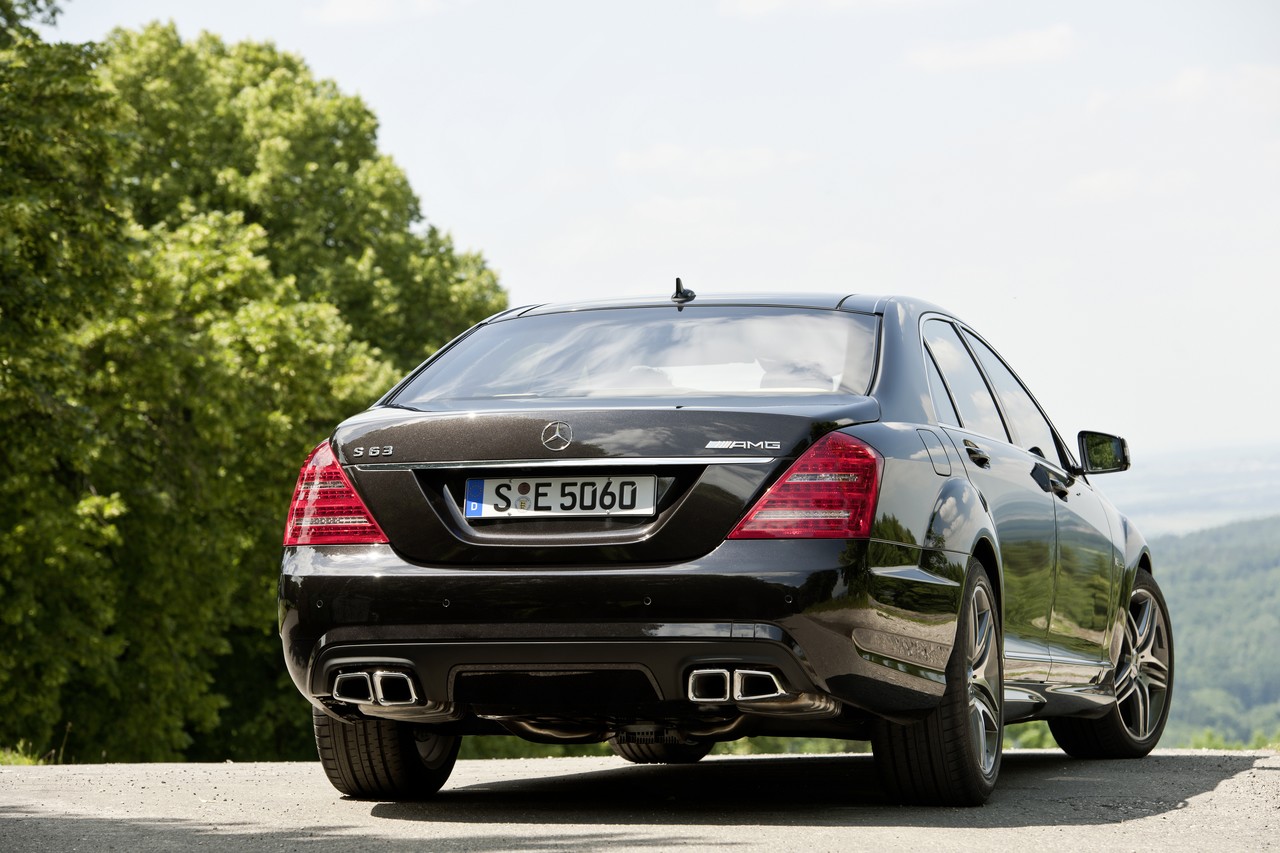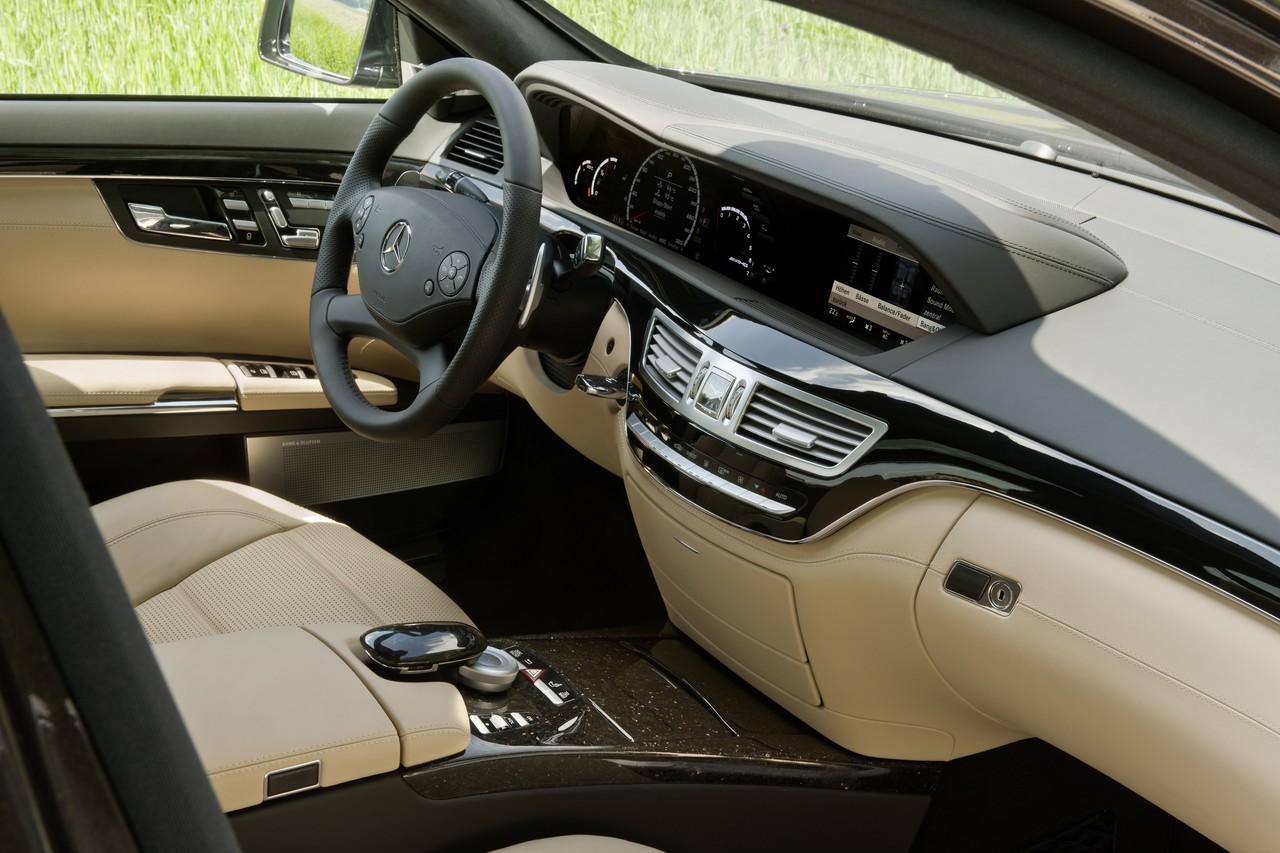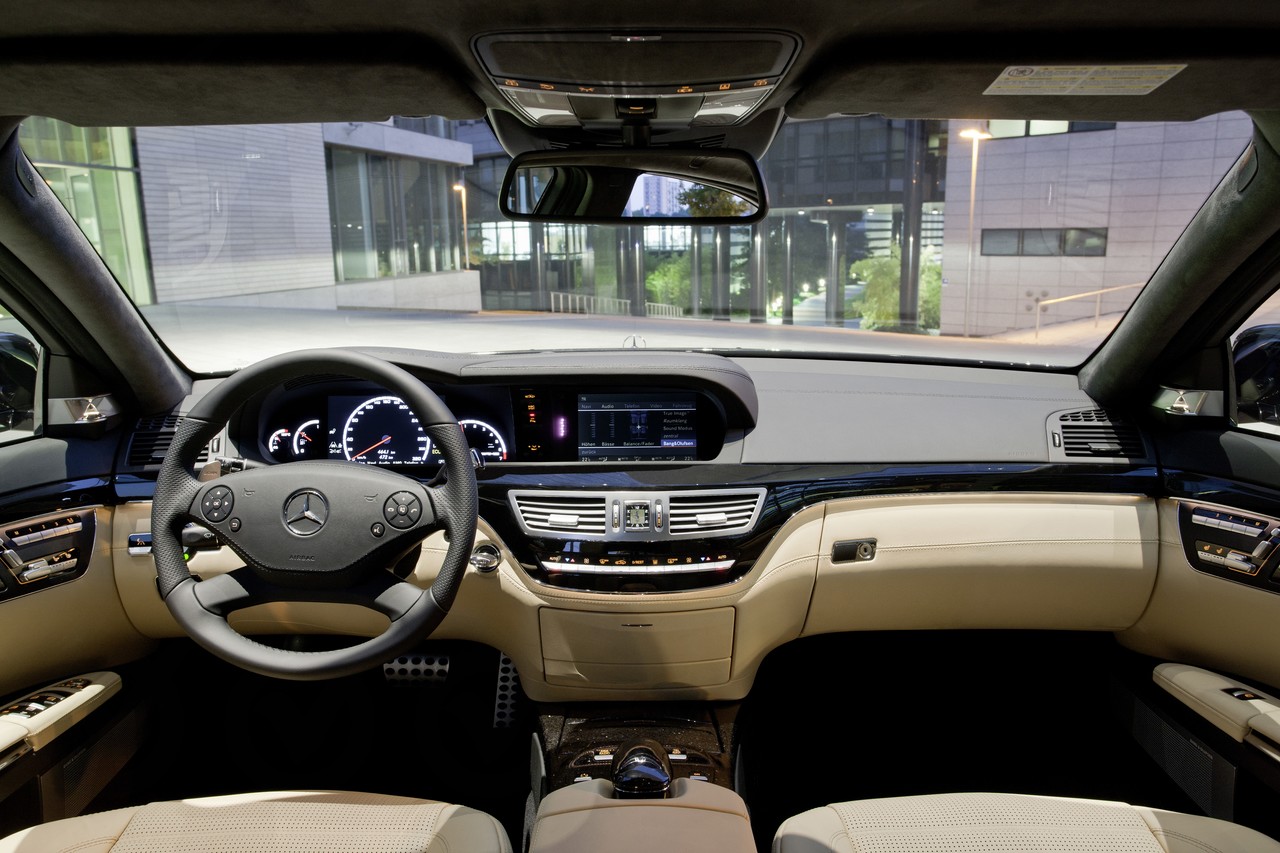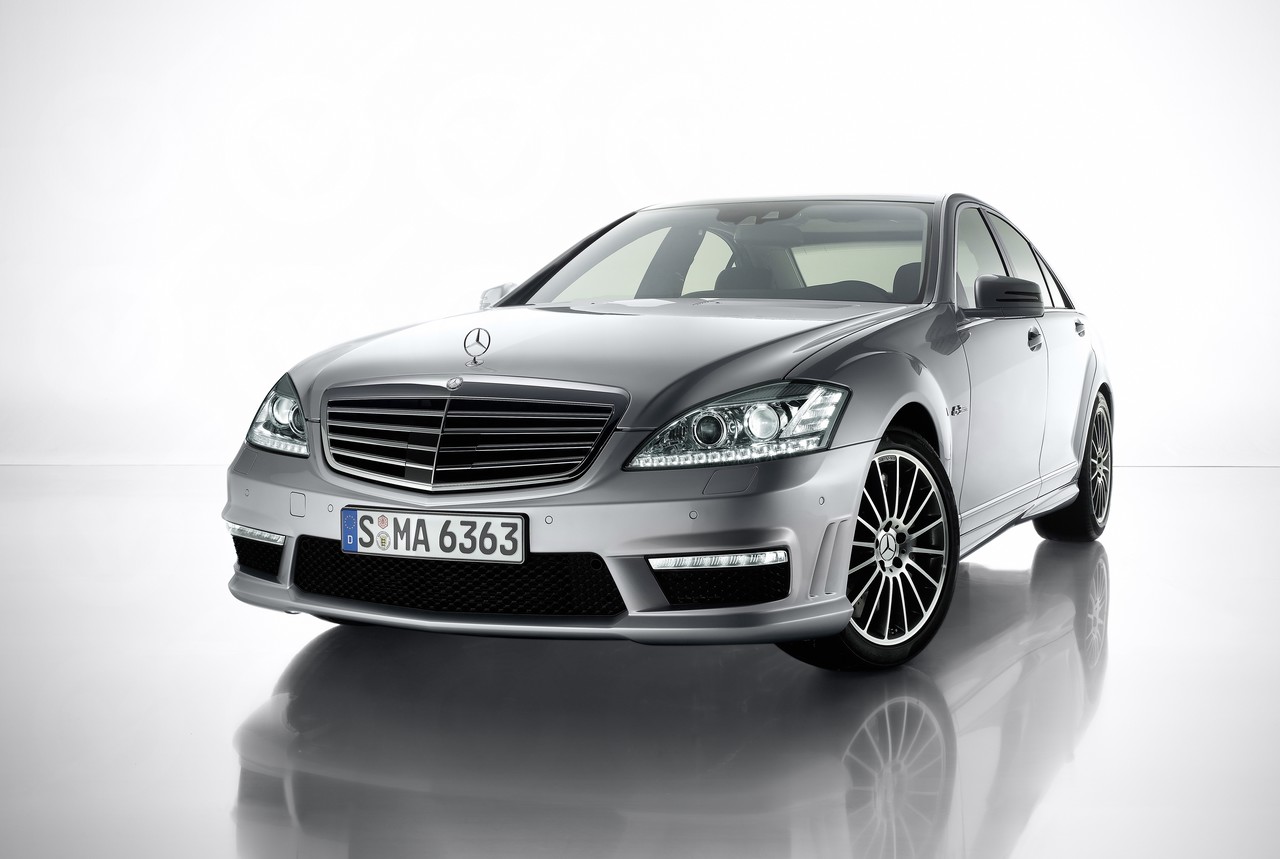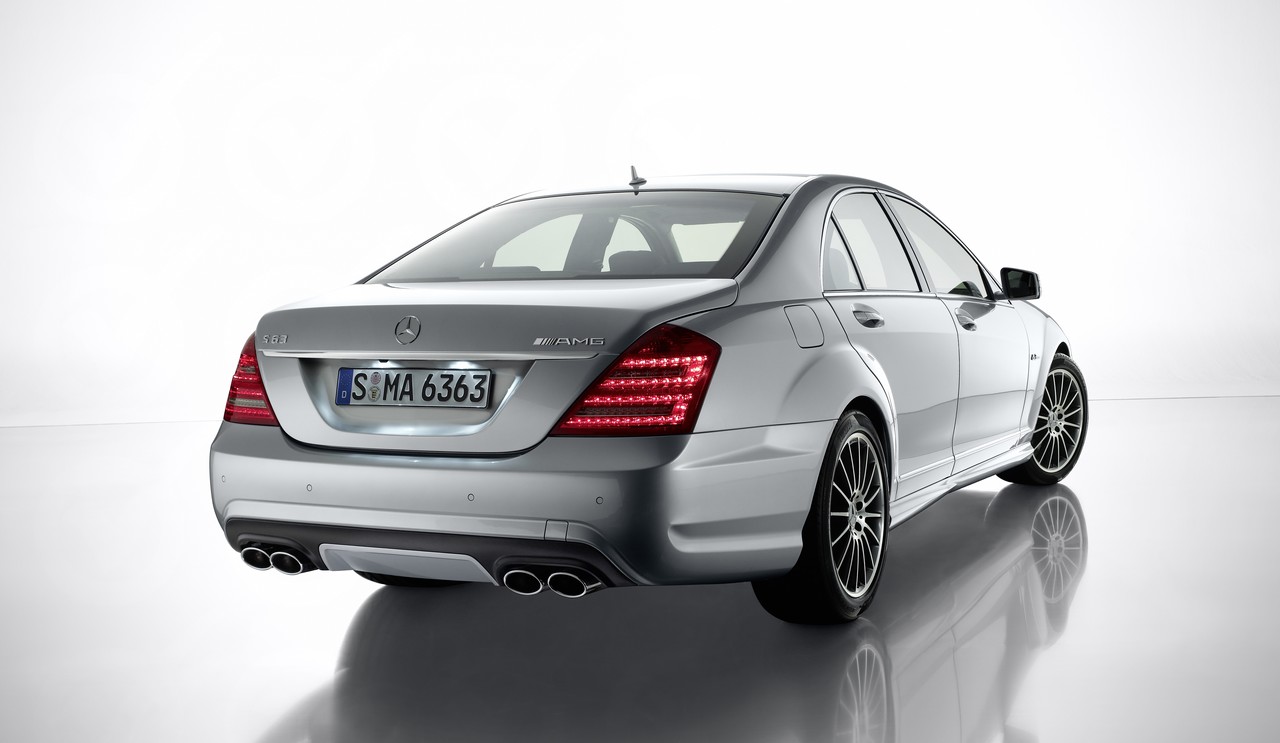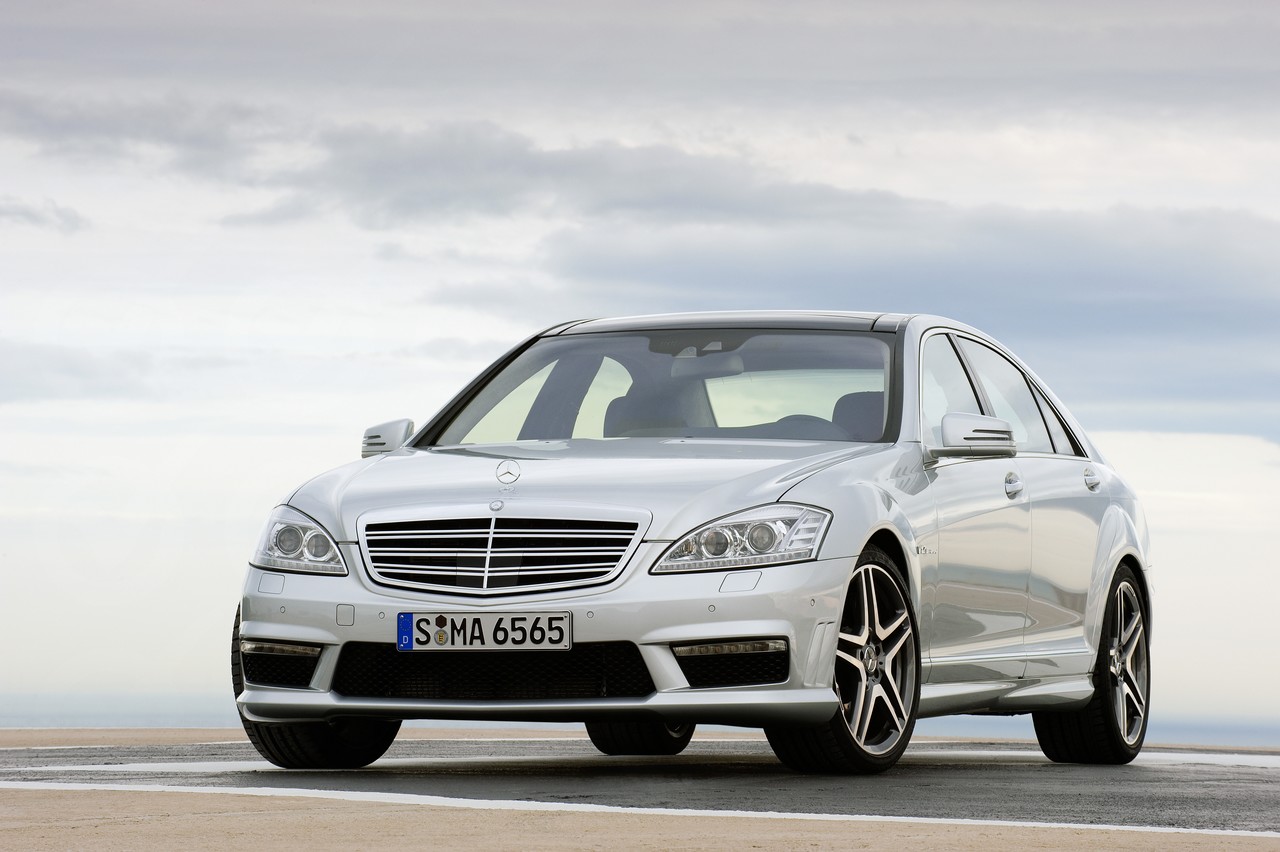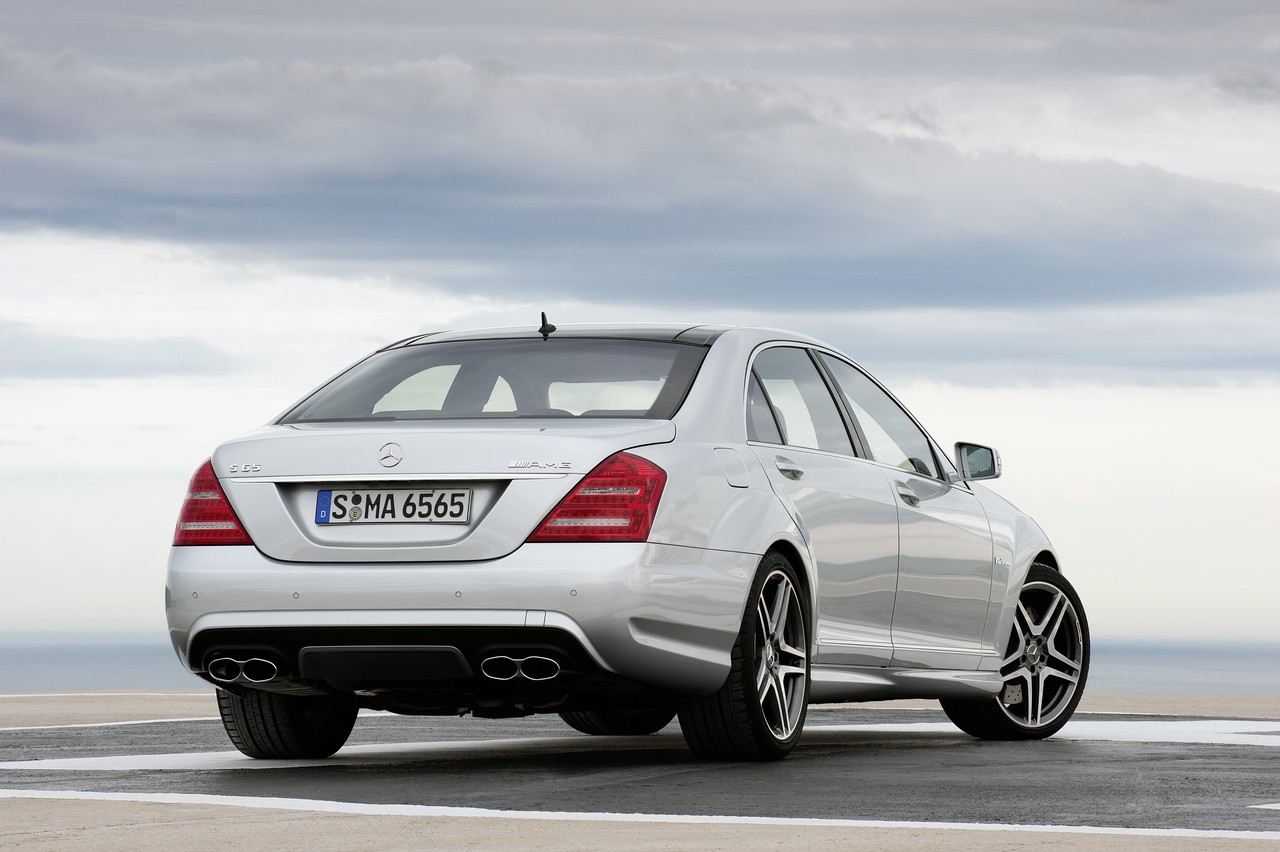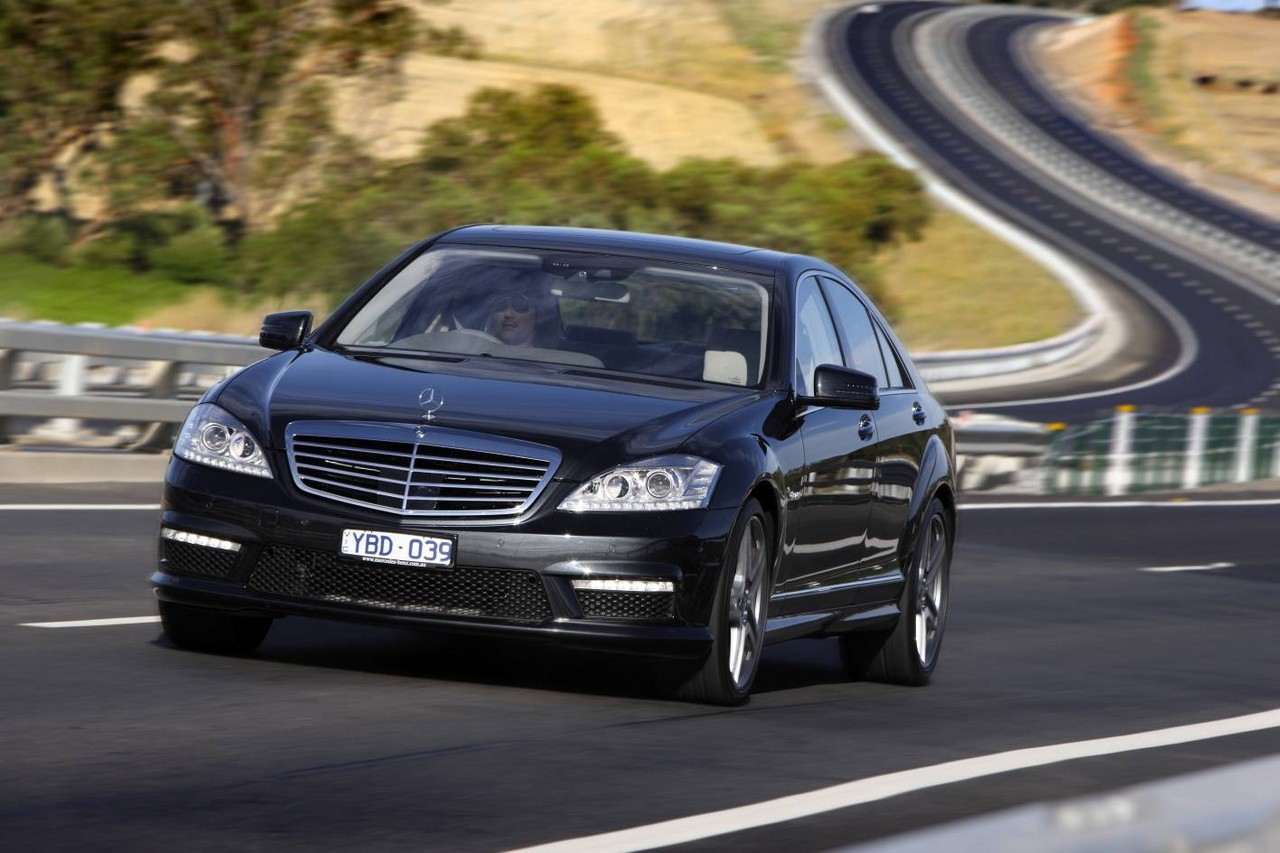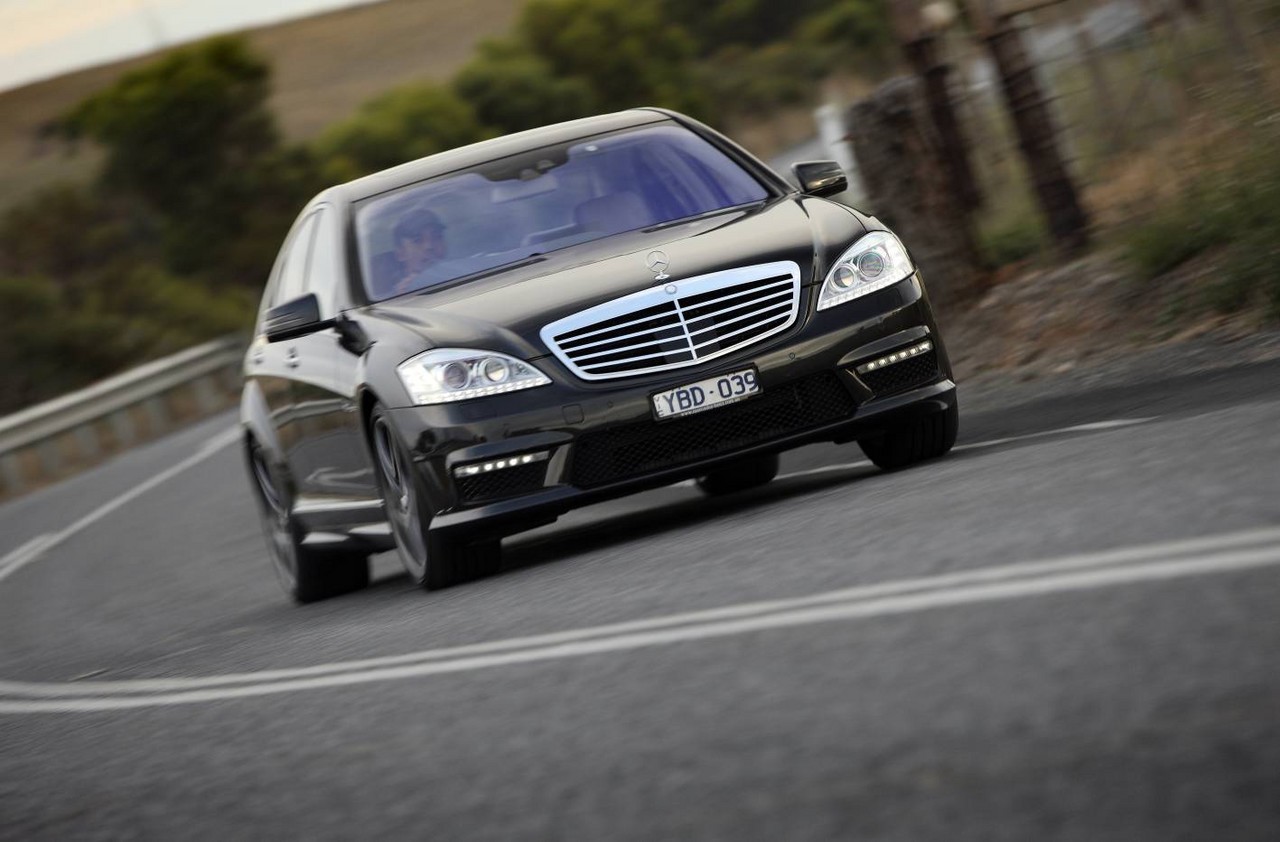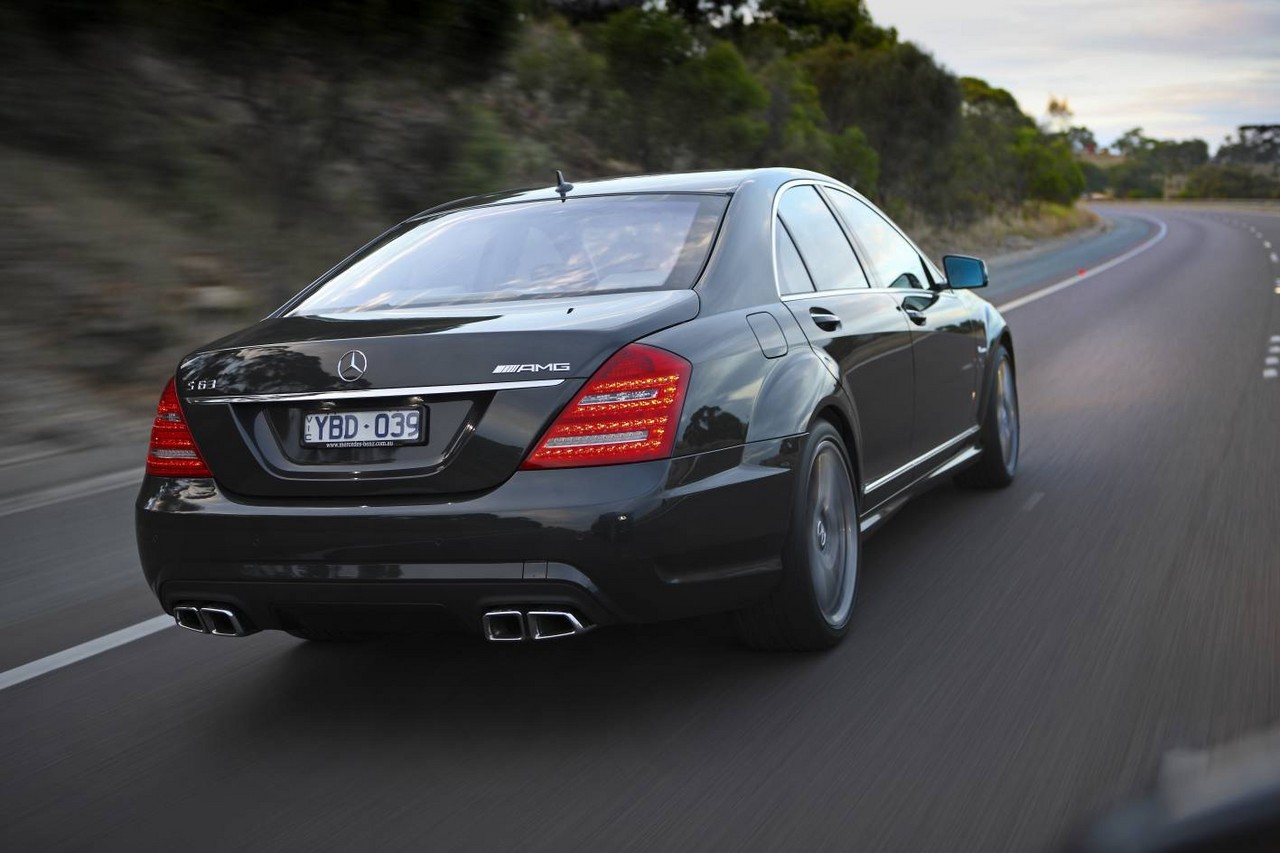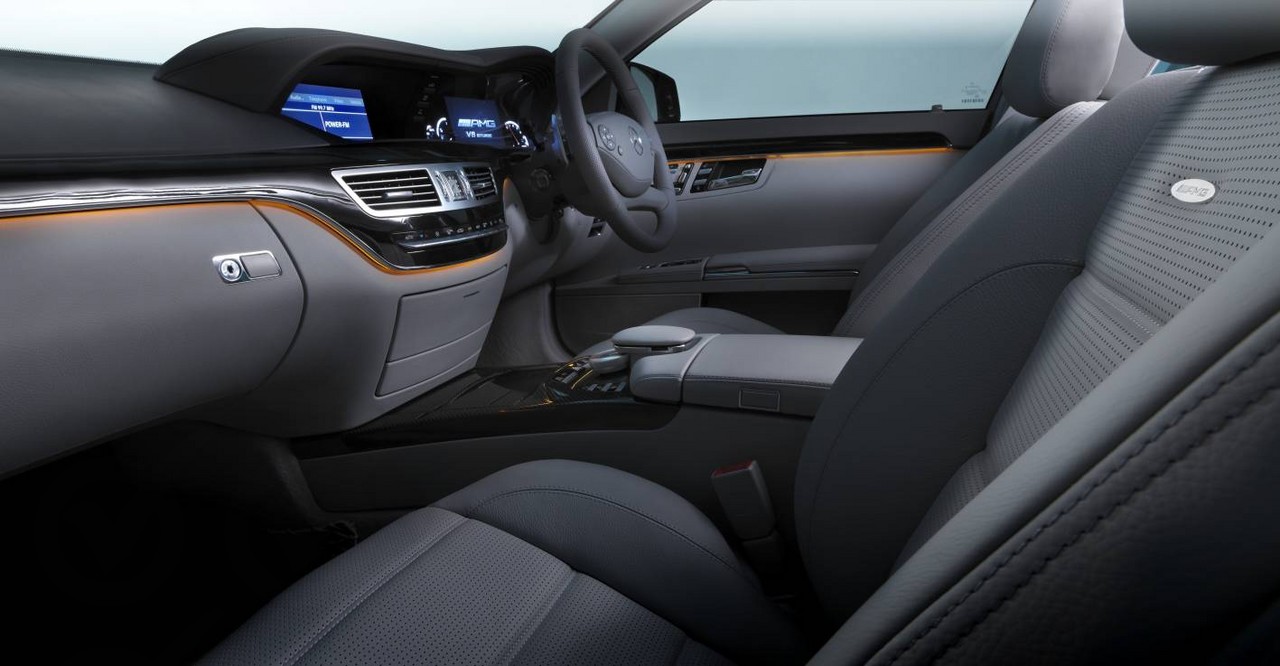
- Eager 6.2-litre M156 V8 engine sounds great
- Powerful biturbo M157 V8 and M275 V12 engines
- Impressive ride/handling balance
- Supportive front seats
- M156 V8 engine susceptible to cylinder head bolt failure, camshaft lobe and valve lifter wear
- High fuel consumption
- High running and maintenance costs
Mercedes W221.I S 63 and V221.I S 65 AMG (2006-09)
Overview
Manufactured in Sindelfingen, Germany, the Mercedes-Benz V221 S 65 AMG was released in Australia in October 2006, with the W221 S 63 AMG following in September 2007. Based on the Mercedes-Benz W221/V221 S-Class , the S 63 AMG and S 65 AMG were powered by 6.3-litre V8 and biturbo 6.0-litre V12 engines, respectively.
S 63 AMG: M156.984 V8 engine
Developed and hand-assembled by Mercedes-AMG in Affalterbach, Germany, the 6208 cc M156.984 V8 petrol engine had an aluminium-silicon alloy (AlSi7) block which had 102.2 mm bores and a 94.6 mm stroke, an aluminium-silicon alloy (AlSi17) cylinder head, a Cromax 42CrMo4V forged steel alloy crankshaft, fracture-split forged connecting rods, cylinder bores with twin-wire-arc-sprayed (TWAS) coating, double overhead camshafts per cylinder bank (intake cams driven by a double chain from the crankshaft and small gears on the intake cams drive the exhaust camshafts), continuously variable intake and exhaust camshafts (over a range of 40 degrees via electrohydraulic vane-type adjusters), four valves per cylinder (40 mm intake valves and 34 mm exhaust valves) with bucket tappets, a magnesium variable intake manifold (with two integral throttle flaps), a compression ratio of 11.3:1 and Bosch 9.7 engine management system. Maximum engine speed for the M156 V8 engine was 7200 rpm.
The S 63 AMG could accelerate from rest to 100 km/h in 4.6 seconds and had an electronically-limited top speed of 250 km/h. Over the combined EUDC cycle, fuel consumption was 14.9 litres per 100 km.
V221 S 65 AMG: M275.982 V12 engine
The 5980 cc M275.982 V12 engine had a reinforced aluminium alloy block with 82.6 mm bores and a 93.00 mm stroke, an aluminium cylinder head, twin turbochargers, manifold injection, a single overhead camshaft per cylinder bank (SOHC), three valves per cylinder (two intake and one exhaust) that were actuated by aluminium roller rocker arms, two spark plugs per cylinder, and a compression ratio of 9.0:1. Furthermore, the twin turbochargers – one per cylinder bank – had air-to-liquid intercooler and provided peak boost pressure of 1.52 bar (22.1 psi).
Compared to the standard 6.0-litre biturbo V12, changes for the AMG version included:
- Higher-strength material for the crankshaft;
- Forged pistons were made from a temperature and pressure resistant material and had an upgraded oil-spray cooling system with a separate individual nozzle per piston. The size of the piston pins was also increased;
- The main and connecting rod bearings were made from higher-specification material;
- The combustion chambers in the cylinder heads were optimised;
- The camshafts had increased stroke on the intake side and longer opening times;
- The oil pump was modified and a larger oil cooler used to ensure lubrication under extreme conditions;
- The housings of the compressor and turbine, the turbine and the compressor wheels were enlarged;
- Maximum charge pressure was increased to 1.5 bar;
- Larger injection valve openings increased fuel throughput;
- New intercooler design which featured a 70 per cent larger front-mounted low-radiator;
The system pressure of the computer-controlled fuel system was increased to 3.8 bar; and, - A new engine management system was used, which included new wastegate valve actuation control for both turbochargers.
While the engine could produce peak torque of 1200 Nm, it was electronically-limited to 1000 Nm to protect the transmission. However, the M275.982 engine could produce 570 Nm at 1000 rpm and 750 Nm at 1500 rpm.
The S 65 AMG could accelerate from rest to 100 km/h in 4.4 seconds and to 200 km/h in 13.3 seconds; its top speed was electronically-limited to 250 km/h. Over the combined EUDC cycle, fuel consumption was 14.8 litres per 100 km.
| Years | Engine | Trans. | Peak power | Peak torque | |
|---|---|---|---|---|---|
| W221.I S 63 AMG |
2007-09 | 6.2-litre petrol V12 (M156) | 7sp auto | 386 kW at 6800 rpm | 630 Nm at 5200 rpm |
| V221.I S 65 AMG |
2006-09 | 6.0-litre twin-turbo petrol V12 (M275) | 5sp auto | 450 kW at 4750-5100 rpm | 1000 Nm at 2000-4000 rpm |
AMG Speedshift and AMG Speedshift 7G-Tronic transmissions
The S 63 AMG and S 65 AMG engines were mated to AMG Speedshift and AMG Speedshift 7G-Tronic transmissions, respectively. Both transmissions had three selectable drive modes – Comfort (C), Sport (S) and Manual (M) – which affected transmission programming, throttle response and spring/damper settings of the ‘AMG sports suspension’ with Active Body Control. Furthermore, the driver could shift gears, at any time, by using the steering wheel gearshift paddles.
For the S 63 AMG, the gear ratios were 4.38 (1st), 2.86 (2nd), 1.92 (3rd), 1.37 (4th), 1.00 (5th), 0.82 (6th) and 0.73 (7th), with a final drive ratio of 3.06. For the S 65 AMG, the ratios were 3.60 (1st), 2.19 (2nd), 1.41 (3rd), 1.00 (4th) and 0.83 (5th), with a final drive ratio of 2.65.
Other features of the AMG Speedshift transmissions included:
- A downshift braking function if deceleration conditions were satisfied; and,
- Delayed gear shifting if a certain level of lateral acceleration was present, to prevent gearshifts when cornering.
Dimensions and body
Compared to the W220 S 55 AMG which preceded it, the W221 S 63 AMG was 33 mm longer (at 5076 mm), 16 mm wider (1871 mm), 29 mm taller (1473 mm) and had a 70 mm longer wheelbase (3035 mm); kerb weight increased by 85 kg to 2070 kg. Compared to the W220/V220 S-Class , the body of the W221/V221 generation achieved a 12 per cent increase in static torsional rigidity.
Relative to the W221 S 63 AMG, the V221 S 65 AMG had a 130 mm longer wheelbase and was 130 mm longer overall, at 3165 mm and 5206 mm, respectively. Furthermore, kerb weight increased by 180 kg to 2250 kg.
Suspension and Active Body Control
The S 63 AMG and S 65 AMG had four-link front suspension and multi-link rear suspension. The suspension featured Mercedes-Benz’s ‘Active Body Control’ (ABC) which used four computer-controlled spring struts with plunger cylinders to compensate for roll, pitch and vertical movements. Using acceleration sensors, pressure sensors in the spring struts and level sensors in the control arms, the on-board computer activated servo-hydraulic valves in the front and rear axle to control oil flow rates. Oil flowing into the plunger’s cylinders then moved the base of the steel springs that were integrated in the spring struts to counter the body’s movements.
The ABC system sought to control body vibrations up to five (5) hertz that were typically caused by rolling and vertical movements on uneven road surfaces, body roll when cornering and pitching when braking. Higher frequency vibrations, however, were to be absorbed by passive twin-tube gas-charged shock absorbers.
Steering
The Mercedes S 63 AMG and S 65 AMG had rack-and-pinion steering with speed-sensitive power assistance (Mercedes-Benz’s ‘parameter steering’).
Safety equipment
Standard safety equipment for the Mercedes S 63 AMG and S 65 AMG included dual front airbags, front and rear side airbags, full-length curtain airbags, ABS, electronic brake force distribution, brake assist, electronic stability control, traction control, active front seat head restraints and front and outer rear seatbelts with pre-tensioners and load limiters.
The S 63 AMG and S 65 AMG were also fitted with:
- Mercedes-Benz’s ‘Pre-Safe’ which, in the event that an accident was anticipated, would prepare the vehicle by tensioning the front seat belts, inflating the air cushions in the multicontour seats and closing the sunroof and windows (if open);
- ‘Night View Assist’ which utiltised two infra-red headlights and an infra-red camera on the inside of the windscreen to record the reflected image of the road ahead – over 150 metres away – and display the image in the instrument cluster; and,
- Brake Assist Plus: used a 24 GHz radar sensor with a range of 30 metres and a 77 GHz radar sensor with a range of 150 metres to monitor the distance to the vehicle ahead and would warn the driver if there was a risk of a collision. Brake Assist Plus could detect vehicles when travelling at speeds up to 200 km/h, and stationary objects when the driver was travelling at 7 km/h to 72 km/h. Significantly, Brake Assist Plus could calculate the necessary brake force assistance to prevent a rear-end collision, build up that pressure in the braking system and provide it as soon as the brake pedal was depressed for ‘the best possible deceleration’. In emergency braking situations, the brake lights would also rapidly flash to warn following traffic.
Beyond this, the S 65 AMG was equipped with Distronic Plus, an ‘adaptive cruise control’ system which combined 24 GHz radar sensors which had a range of around 30 metres and a 77 GHz radar which had a range of 150 metres. Operating at speeds up to 200 km/h, Distronic Plus used an electronic control unit to analyse the information from both radar systems to calculate the engine, automatic transmission and braking parameters required for proximity control. As such, Distronic Plus could automatically apply the brakes to prevent the vehicle from becoming too close to traffic ahead (the time interval could be specified) and accelerate back to the set speed when traffic allowed. To accelerate from rest, the driver only needed to operate the Distronic stalk on the steering column or briefly depress the accelerator pedal. With Distronic Plus, automatic deceleration of up to four (4) m/s2was possible. If Distronic Plus detected that heavier braking was required, a warning light would illuminate in the instrument cluster and be accompanied by an audible warning. Furthermore, the electronic proximity control system could be activated independently of Distronic Plus at speeds over 30 km/h to alert the driver if they were approaching another vehicle too rapidly.
Brakes: S 63 AMG and S 65 AMGG
The S 63 AMG and S 65 AMG had 390 mm composite front brake discs with twin sliding callipers and 365 mm composite rear brake discs with a sliding frame-type calliper.
According to Mercedes-Benz, the twin-sliding calliper combined the advantages of a floating-calliper brake (i.e. lower heat transfer to the brake fluid and improved ride comfort due to the location of the brake pads) with the performance of a large fixed-calliper brake.
Features: Mercedes S 63 AMG
Standard features for the Mercedes S 63 AMG included 19-inch alloy wheels (8.5J front and 9.5J rear) with 255/40 ZR19 XL front and 275/40 ZR 19 XL rear tyres, a Harmon/Kardon Logic7 surround sound system with fourteen speakers and a six-disc CD/DVD player, COMAND (Cockpit Management and Data System) with colour display, hard drive-based satellite navigation, memory card port (for PCMCIA cards), voice recognition (‘Linguatronic’), TV tuner and telephone, dual-zone climate control air conditioning, ‘Passion’ leather upholstery, multi-contour AMG front sports seats with twelve-way power adjustment, front seat heating and ventilation functions, cruise control, directional bi-xenon headlights with washer jets, front and rear fog lights, front and rear parking sensors, automatic headlights, rain-sensing wipers and self-closing windows, an AMG steering wheel, remote central locking, power adjustable mirrors with heating and folding functions, automatic kerbside view mirror tilting on reverse, power windows, a power adjustable steering column (for height and reach), an anti-glare rear view mirror, memory settings (front seats, mirrors, steering wheel), a power sunroof, power-operated park brake, tyre pressure and brake pad monitoring, tinted glass, cargo net, an ‘IWC Ingenieur’ design analogue clock, a trip computer and an immobiliser.
Features: Mercedes S 65 AMG
Compared to the S 63 AMG, the Mercedes S 65 AMG was further equipped with 19-inch multi-piece AMG alloy wheels (8.5J front and 9.5J rear) with 255/40 ZR19 XL front and 275/40 ZR 19 XL rear tyres, four-zone climate control air conditioning, ‘Exclusive Passion’ leather upholstery, a reversing camera, proximity key and push-button start (‘keyless go’), a remotely closing bootlid, burr walnut wood trim and motion-sensing alarm. Like the V221 S-Class, the S 65 AMG was also fitted with a power-operated rear blind and power adjustable outer rear seats.
From August 2007, S 65 AMG fitted with 20-inch alloy wheels with 235/35 R20 front and 275/35 R20 rear tyres.
Related links
- Press Kit: Mercedes-Benz W221/V221 S-Class – safety development (August 2005)
- Press Kit: Mercedes-Benz W221/V221 S-Class – new engines (August 2005)
Mercedes W221.II S 63 and V221.II S 65 AMG (2009-11)
Overview
Released in October 2009, Mercedes-Benz W221 and V221 Series II (W221.II and V221.II) S 63 and S 65 AMG introduced new safety and driving technologies. Visually, the W221.II S 63 AMG and V221.II S 65 AMG could be identified by their more pronounced arrow-shaped radiator grilles (with twin chromed louvres for the S 65 AMG), new front aprons with AMG-specific LED daytime driving lights, and redesigned door mirrors. At the rear, they had new rear aprons with body-coloured paint for the centre section of the black diffuser insert, and new tail-lights with 52 LEDs that formed a double ‘C’ when illuminated.
For the Active Body Control suspension, a cross-wind stabilisation function was introduced which compensated for cross-winds by adjusting wheel load distribution (based on inputs from the yaw and lateral acceleration sensors of the electronic stability control system).
For greater handling precision, a ‘Torque Vectoring Brake’ function was introduced which could briefly brake the inner rear wheel when cornering.
| Engine | Trans. | Peak power | Peak torque | |
|---|---|---|---|---|
| W221.II S 63 AMG |
6.2-litre petrol V12 (M156) | 7sp auto | 386 kW at 6800 rpm | 630 Nm at 5200 rpm |
| V221.II S 65 AMG |
6.0-litre twin-turbo petrol V12 (M275) | 5sp auto | 450 kW at 4750-5100 rpm | 1000 Nm at 2000-4000 rpm |
Safety equipment
Standard safety equipment for the W221.II S 63 AMG and V221.II S 65 AMG were extended to include:
- Pre-Safe Brake (autonomous emergency braking): using two 24 GHz sensors behind the front bumper which had a range of 30 metres and a 77 GHz radar which had a range of 150 metres, Pre-Safe Brake operated at speeds between 30 km/h and 200 km/h, and at speeds below 70 km/h if the vehicle was approaching a stationary queue of traffic. Around 2.6 seconds before the anticipated moment of impact, an audible warning would sound and a red warning would appear in the tachometer. Around 1.6 before the calculated impact, the first stage of Pre-Safe Brake would initiate partial braking autonomously with around 40 per cent of the maximum braking power (approximately four (4) m/s2); the Pre-Safe occupant protections system would also be activated. If the driver then applied the brakes, maximum braking force would be made available. If the driver failed to react, Pre-Safe Brake would – in its second stage – initiate autonomous emergency braking (i.e. maximum braking power) around 0.6 seconds before the unavoidable collision to reduce the severity of the impact;
- Lane Keeping Assist: used a camera on the windscreen to detect lane markings. If the vehicle unintentionally departed from its lane, the driver would be warned by short vibrations of the steering wheel; and,
- ‘Attention Assist’: monitored 70 different patterns and, once steering behaviour was detected that typically indicated the onset of drowsiness, a warning signal would sound and a message would appear in the instrument cluster.
The S 63 AMG also gained Distronic Plus which was previously limited to the S 65 AMG. Furthermore, Night View Assist was upgraded to highlight pedestrians to make them more noticeable (‘Night View Assist Plus’).
Features: Mercedes S 63 AMG and S 65 AMG
Standard features for the Mercedes S 63 AMG and S 65 AMG were extended to include ‘Splitview’ central monitor (which could display different content to the driver and front passenger from the same monitor), USB and SD card interfaces, a 7.2 GB hard-drive music register, Bluetooth connectivity, a reversing camera with parking guidance and ‘keyless go’.
Press Kit
Related links
- Press Kit: Mercedes-Benz W221.II and V221.II S-Class (May 2009)
- Press Kit: Mercedes-Benz S 63 AMG and S 65 AMG enhancements (June 2009)
- Press Kit: Mercedes-Benz S-Class – voice control system (August 2009)
- Press Kit: Mercedes-Benz W221.II S 63 AMG (July 2010)
Mercedes-Benz W221.III S 63 and V221.III S 65 AMG (2011-13)
Overview
Released in Australia in February 2011, the Mercedes-Benz W221.III S 63 AMG was powered by Mercedes-Benz’s 5.5-litre M157 twin-turbo V8 engine, while the V221.III S 65 AMG engine was revised and fitted with new turbochargers.
S 63 AMG: M157 twin-turbo V8 engine
The M157 V8 engine had an aluminium block with cast-in aluminium-silicon (Silitec) cylinder liners, forged crankshaft made of 38MnS6BY steel alloy (a combination of manganese, sulphur, boron and yttrium) with eight counterweights and rotating in five main bearings, fracture-split forged connecting rods, an aluminium cylinder head, double overhead camshafts (driven by three high-performance chains), variable intake and exhaust camshaft adjustment over a range of 40 degrees via four pivoting actuators, four valves per cylinder and a compression ratio of 10.0:1. Furthermore, the M 157 had a dry weight of 204 kg, maximum engine speed of 6400 rpm and Bosch MED 17.7.3 control unit.
Significantly, the M157 engine had spray-guided direct injection with piezo fuel injectors (operating at 100 to 200 bar on a demand-related basis), a Garrett MGT2260MSL turbocharger for each cylinder bank (welded to the exhaust manifold) and air/water intercooling. For the S 63 AMG, maximum charge pressure was 1.0 bar. For greater fuel efficiency, the M157 engine had an ‘ECO start/stop system’ – which the driver could disable if desired – and multi-spark ignition whereby the spark plugs could fire multiple times during the combustion sequence for more efficient combustion.
With M157 engine, the S 63 AMG could accelerate from rest to 100 km/h in 4.5 seconds. Over the combined NEDC test cycle, fuel consumption was 10.5 litres per 100 km.
S 63 AMG: AMG Speedshift MCT
First introduced in the R230 SL 63 AMG in 2008, the seven-speed ‘AMG Speedshift MCT’ (Multi Clutch Technology) had a compact, wet start-up clutch that operated in an oil bath rather than a conventional torque converter. Furthermore, the AMG Speedshift transmission had selectable driving modes:
- Controlled Efficiency, ‘C’, for softer throttle response, smooth gearshifts, early upshifts to minimise fuel consumption and acceleration from rest in second gear;
- Sport, ‘S’, for greater throttle response, higher engine speeds before upshifting and gearshifts around 25 per cent faster than Comfort. For fast gearshifts under full loads, the engine could partially suppress individual cylinders by interrupting ignition and injection; and,
- Manual, ‘M’, for maximum throttle response and gearshifts 50 per cent faster than Comfort (as quickly as 100 milliseconds).
Other features of the AMG Speedshift transmission included:
- Automatic throttle-blipping on downshifts;
- A double-declutching function for multiple downshifts; and,
- A ‘Race Start’ function.
Compared to the AMG Speedshift 7G-Tronic transmission, the gear ratios for the MCT unit were unchanged, i.e. 4.38 (1st), 2.86 (2nd), 1.92 (3rd), 1.37 (4th), 1.00 (5th), 0.82 (6th) and 0.73 (7th); the final drive ratio, however, was reduced from 3.06 to 2.65.
S 65 AMG: M275 engine
For the S 65 AMG, the M275 engine was fitted with new turbochargers which had larger inlet compressor housings and exhaust gas ducts for greater air throughput; maximum charge pressure, however, remained at 1.5 bar.
Other changes included new piston rings, a modified oil pump, variable alternator and new engine electronics. Over the combined NEDC test cycle, fuel consumption was 14.3 litres per 100 km (previously 14.5 litres per 100 km).
| Engine | Trans. | Peak power | Peak torque | |
|---|---|---|---|---|
| W221.III S 63 AMG |
5.5-litre twin turbo petrol V8 (M157) | 7sp semi-auto | 400 kW at 5500 rpm | 800 Nm at 2000-4500 rpm |
| V221.III S 65 AMG |
6.0-litre twin turbo petrol V12 (M275) | 5sp auto | 463 kW at 4800 rpm | 1000 Nm at 2300-4300 rpm |
Safety equipment
Compared to their predecessors, standard safety equipment for the W221.III S 63 AMG and V221.III S 65 AMG were extended to include:
- Active Lane Keeping Assist, which used the stability control system to autonomously brake wheels on one side of the vehicle to keep prevent it from drifting into another lane; and,
- Active Blind Spot Assist, which would also autonomously brake wheels on one side of the vehicle to prevent collisions with objects outside the driver’s field of vision.
Features
Standard features for the Mercedes S 63 AMG were largely unchanged, though the S 65 AMG was fitted with 1200 watt Bang and Olufsen BeoSound AMG sound system which had fifteen speakers, digital sound processing and acoustic lens tweeters in the A- and B-pillars.
Brochure
Related links
